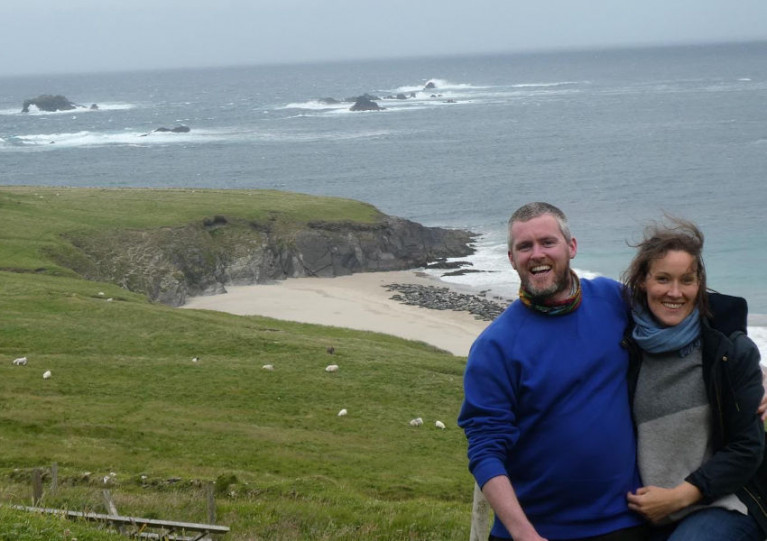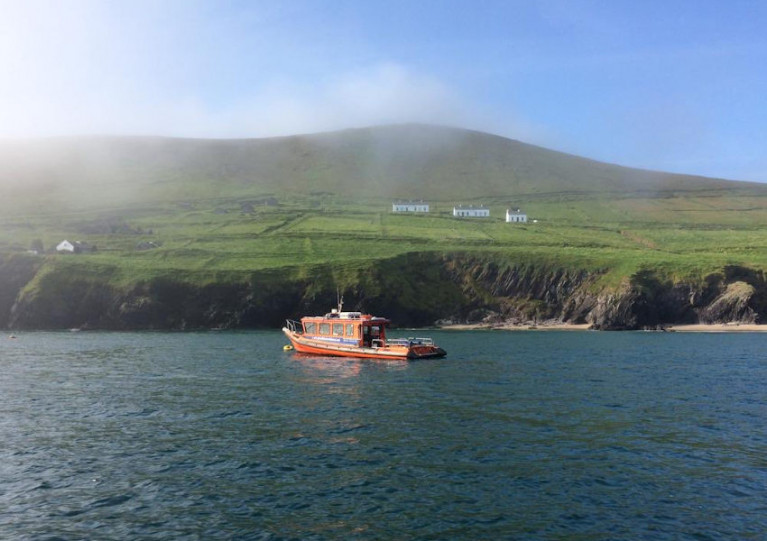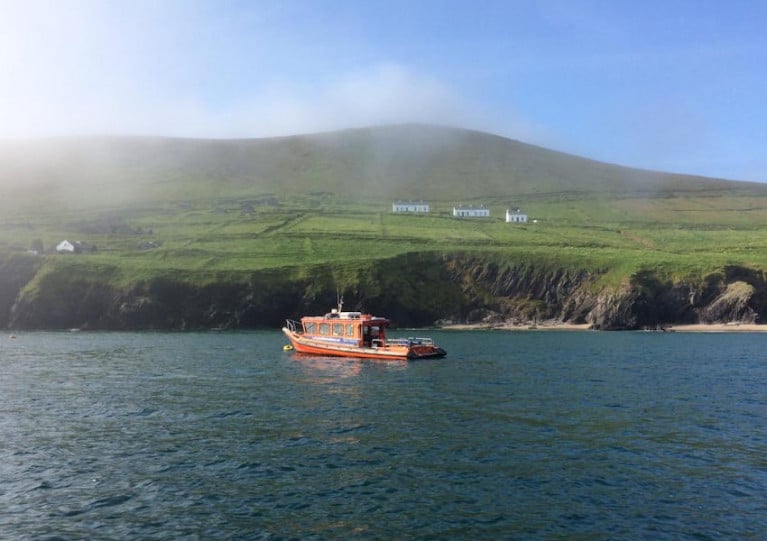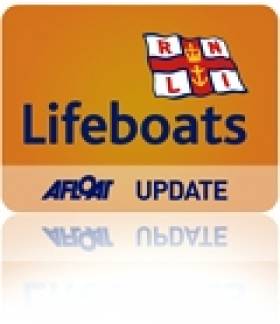Displaying items by tag: Great Blasket Island
Kerry’s Beloved Peig Sayers Blasket Island Ferry Boat to be Re-Engined
Kerry's Peig Sayers ferry has been a popular mode of transportation for tourists travelling from Dingle Harbour to the Great Blasket Island for more than two decades.
The island ferry is owned by Billy O'Connor, who took over the business from his grandfather and granduncle in 2014. Billy operates the Great Blasket Island Experience, a seasonal tourism enterprise that offers full-day eco-tours from April to October and overnight stays in three cottages on the island. The ferry, a Red Bay Stormforce 11 RIB built in County Antrim, also transports goods from the mainland throughout the year and manages the island's ecosystem during the off-season.
 The island ferry is owned by Billy O'Connor, who took over the business from his grandfather and granduncle in 2014
The island ferry is owned by Billy O'Connor, who took over the business from his grandfather and granduncle in 2014
However, the ageing ferry has been causing problems for Billy's business due to frequent engine breakdowns. To address this issue, the Brexit Blue Economy Enterprise Scheme, implemented by Bord Iaschaigh Mhara (BIM), has awarded a grant worth €65,000 for fitting the Peig Sayers with new engines. This investment will make the boat more reliable and improve the overall business. The new engines will give the Peig Sayers a new lease of life, ensuring that Kerry's famous ferry will continue to provide invaluable service throughout the year.
This year’s caretakers of Great Blasket Island have spoken of their “beautiful time” on the island looking after its holiday cottages over the summer months.
But they also shared their disappointment at the behaviour or some of the hundreds of visitors to the popular destination off the Co Kerry coast.
Speaking to Newstalk’s Pat Kenny Show, Claire de Haas spoke of one incident where someone picked up and mistreated a newborn seal pup for a selfie — inadvertently causing its death as it was rejected by its mother.
“There is no signage on the island to educate or inform people about general wildlife rules or the seals,” de Haas said.
Another issue is the absence of public toilets on the island, especially since the closure of its single small café.
Reacting to reports of some visitors relieving themselves in the ruins of famed storyteller Peig Sayers’ historic home on the island, Minister of State Patrick O’Donovan told RTÉ News that people should “exercise cop-on”.
“We personally think it’s ridiculous,” said de Haas on the toilet situation. “I think people should be informed before they go on the boat and boat companies inform the guests before they get on.”
Newstalk has more on the story HERE.
Dubliners Settle In As Caretakers On Great Blasket Island
A Dublin couple chosen from thousands of applicants for two caretaker positions on Great Blasket Island have started their new jobs on the remote offshore idyll.
As previously covered on Afloat.ie, well over 20,000 applications were submitted for the two unique summer jobs on the usually uninhabited Co Kerry island.
Originally supposed to cover the usual tourism high season from April to October, the start date had to be postponed bu three months due to the coronavirus pandemic.
But now Eoin Boyle and Annie Birney have taken up residence as caretakers of a coffee shop and accompanying cottage accommodation.
Birney tells BBC News: “If you go for a walk to the back of the island, you could potentially be the most western person in Europe on a body of land.”
Thousands Apply For Great Blasket Island Summer Season Jobs
A whopping 23,000 applications have been received for two unique summer jobs on Great Blasket Island, as RTÉ News reports.
Afloat.ie previously noted the huge response to the vacancies on the usually uninhabited Co Kerry island — for two people, a couple or friends, to run a coffee shop and accompanying cottage accommodation for the busy summer season stretching from April to October.
Now just 10 days after posting their job ad on social media, Alice Hayes and her partner Billy O’Connor say their email “is in meltdown” with applications from as far afield as Iran, Mexico and Argentina.
And the prospective caretakers come from all walks of life — including one “lovely” and “moving” application from an elderly couple.
RTÉ News has much more on the story HERE.
The owners of three rental cottages on Great Blasket Island have been “inundated” with queries about a caretaker vacancy on the Co Kerry island, according to Extra.ie.
The “unique” job position advertised on the Great Blasket Island Twitter account calls for two people — a couple or two friends — for the long-term management of accommodation and a coffee shop on the island between 1 April and October this year.
Lucky applicants will be required to service the cottages as well as serve tea and snacks at the adjacent café during the often busy tourist season. Extra.ie has more on the story HERE.
Fenit Lifeboat Recover Injured Woman from Great Blasket Island
At 03.41 this morning (Thursday 5 August 2010) Fenit RNLI lifeboat crew were requested to launch by Valentia Coast Guard to go to the assistance of a woman injured on the Great Blasket Island. The woman had fallen and sustained injuries to her leg and the Fenit RNLI all weather lifeboat was launched to recover her from the island and bring her ashore to Dingle to a waiting ambulance.
With no slipway or pier on the island and extremely shallow water at the landing point, the only way for the lifeboat crew to access the island was by launching the XP boat (a small inflatable boat carried onboard the lifeboat)
Four crew members went onto the island and made their way to the woman's house which was almost half a mile in and about 600 feet above sea level. The task was made more difficult due to the fact that the ground was extremely wet and slippery.
The woman was placed on a stretcher and carried back down the hill by the RNLI Fenit Lifeboat crew members. The stretcher was then placed across the xp boat and transferred to the lifeboat by the crew.
Commenting on the incident JP Brick of Fenit RNLI said, " This was a challenging callout for the lifeboat crew. The remote location made it difficult to access the island. The lifeboat crew needed to take a stretcher with them for the casualty and then return down the slippery terrain to the waiting XP boat. From there they travelled out to the waiting lifeboat and transferred the casualty onboard. This is where lifeboat crew training and equipment comes to the fore and the medivac was completed successfully."
On medical advice the casualty was brought to Dingle Marina where she was collected by ambulance and transferred to Tralee General Hospital
Related Safety posts
RNLI Lifeboats in Ireland
Safety News
Rescue News from RNLI Lifeboats in Ireland
Coast Guard News from Ireland
Water Safety News from Ireland
Marine Casualty Investigation Board News
Marine Warnings
































































